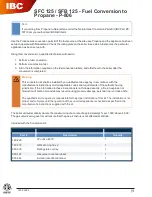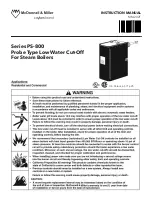
Melbury HE, C 530 - 3000
7
We reserve the right to make changes to dimensions and construction
edition 12.2020
Hamworthy Heating Limited – Dorset BH17 ONF
Adding a large amount of untreated water always contributes a significant amount of scaling. To monitor this and
to detect problems,
a system water meter must be installed.
Failure to comply with these guidelines (such that the fill water plus the make-up water is more than three times
the water capacity of the heating system) requires a full cleaning (to remove sludge and scaling) to be performed.
Additional precautions are required for operation:
When the unit has a water softener, the equipment must be inspected on a regular basis in order to ensure
that it is not outputting chloride-rich water into the system. The concentration of chlorides must always
remain below 50 mg/l.
To prevent the build-up of calcium deposits (such as on exchange surfaces), the unit should be brought into
service slowly, starting by operating at a low power with high primary water flow.
When the tap water lacks the desired qualities,
water treatment is required
. The fill water must be treated,
and whenever new water is added, the make-up water must also be treated.
Installations with multiple boilers require all of the boilers to be brought up simultaneously at minimal power.
Doing this prevents the calcium in the water from depositing on the exchange surfaces of the first boiler.
When working on the unit, avoid draining it completely; only the required parts of the system are to be
drained.
The rules listed above are designed to minimize scaling on the exchange surfaces and thus to increase the life of
the boilers.
To optimize how the equipment operates, plan to remove its calcium deposits. This must be done by a specialized
company. Also, before putting the unit into service, verify that the heating system is not damaged (ex. leaks). If it
has excessive scaling, the unit's settings for operation and for water treatment must be adjusted.
Protecting steel and stainless-steel boilers against corrosion
Corrosion can affect the iron components used in boilers and heating systems, which is directly related to the
presence of oxygen in the water heater's water. Dissolved oxygen that enters the unit when it is being filled for the
first time reacts with the equipment materials and quickly disappears. Without refreshing the oxygen through
significant contributions of water, the unit might not experience any damage whatsoever.
However, it is important to follow the sizing rules and installation guidelines in order to prevent oxygen from
continuously flowing into the heating water. From these rules, we have:
Preferably an expansion vessel with a membrane rather than an open expansion vessel that allows direct
passage
Internal pressure with the unit of more than 1 bar cold
Remove leaky (permeable) components that are letting out more gas than as if they were sealed.
If the guidelines above are followed, the unit's system water has the proper characteristics to last a long time:
8.2 < pH < 9.5 with a water concentration of < 0.1 mg/l.
If there is a chance that oxygen could enter the unit, you must take additional precautions. Adding an oxygen
scavenger (ex. sodium sulphite) is highly recommended. We recommend directing any water treatment questions
to specialists, which can provide:
- The appropriate treatment based on the characteristics of the unit
- A monitoring agreement with a guarantee as to the results
For units in which
the water comes into contact with heterogeneous materials
, such as copper or aluminum,
appropriate treatment is recommended
in order to ensure that the unit will last. In most cases, this consists of
adding corrosion inhibitors (in the form of chemical solutions) to the unit. Referring to a water treatment specialist
is recommended.
Setting up a filtration system
A filtration system on the back of the boiler is recommended in order to remove suspended particles from the unit.
Choice of burner / boiler
We recommend adopting modulating burners to avoid thermal shock in operation.
Hydraulic
Set up an effective degasser as close as possible to the boiler outlet to evacuate the air from the networks
introduced during the filling and the addition of water in order to maintain a good convection coefficient.
Add an additional expansion vessel if the characteristics of the pressure maintenance unit do not allow the
pressure variations to be limited to 0.5 bar in order to limit the variations in hydraulic pressure.
Respect the minimum flow rates recommended. (chapter 4.6.1 to 4.7.2)
Exploitation
The frequency of cold starts should be as low as possible; during these periods, the flue gas temperature can be
low and cause condensation that is detrimental to the life of the boiler; it is recommended not to exceed a cold
start per week.
Содержание Melbury HE 530
Страница 2: ......










































